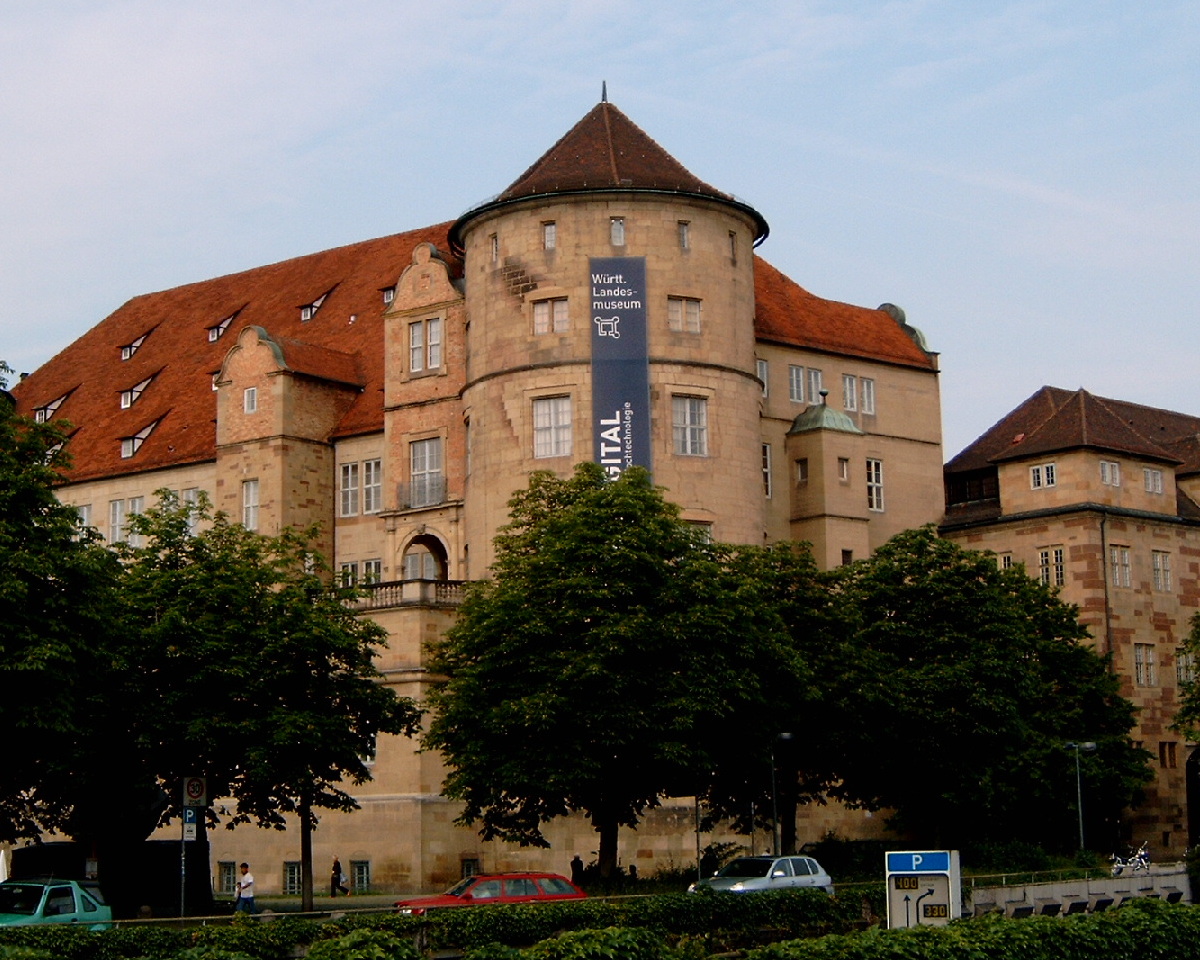Landesmuseum Württemberg on:
[Wikipedia]
[Google]
[Amazon]
 The Landesmuseum Württemberg (Württemberg State Museum) is the main historical museum of the Württemberg part of the German state of
The Landesmuseum Württemberg (Württemberg State Museum) is the main historical museum of the Württemberg part of the German state of 
Official web site (Select Language menu at top)Museum of Everyday Culture
(German)
Playing Card Museum
(German) {{DEFAULTSORT:Landesmuseum Wurttemberg Museums in Stuttgart History museums in Germany 1862 establishments in the German Confederation Museums established in 1862 19th-century establishments in Württemberg National museums of Germany
 The Landesmuseum Württemberg (Württemberg State Museum) is the main historical museum of the Württemberg part of the German state of
The Landesmuseum Württemberg (Württemberg State Museum) is the main historical museum of the Württemberg part of the German state of Baden-Württemberg
Baden-Württemberg ( ; ), commonly shortened to BW or BaWü, is a states of Germany, German state () in Southwest Germany, east of the Rhine, which forms the southern part of Germany's western border with France. With more than 11.07 million i ...
. It emerged from the 16th-century “Kunstkammer” ( Cabinet of art and curiosities) of the dukes, later kings, of Württemberg
Württemberg ( ; ) is a historical German territory roughly corresponding to the cultural and linguistic region of Swabia. The main town of the region is Stuttgart.
Together with Baden and Province of Hohenzollern, Hohenzollern, two other histo ...
who resided in Stuttgart
Stuttgart (; ; Swabian German, Swabian: ; Alemannic German, Alemannic: ; Italian language, Italian: ; ) is the capital city, capital and List of cities in Baden-Württemberg by population, largest city of the States of Germany, German state of ...
. As a museum it was founded in 1862 by King William I.

Collections in Stuttgart and Waldenbuch
The museum's main location is the Old Castle in Stuttgart. The nearby granary and the cellar of the New Castle also contain parts of the collections as well as Waldenbuch Castle outside of Stuttgart. The collections are grouped into eight divisions: * Schausammlung ''LegendäreMeisterWerke'' (Legendary Masterpieces) ** archeology: Paleolithic, Neolithic, Bronze Age, Iron Age, antiquity, Romans in Württemberg, early Middle Ages ** history of art and cultural history: Württemberg crown jewels, medieval art, modern glass painting * Schausammlung ''Wahre Schätze'' (Real Treasures) ** Antikensammlung - Museum of Ancient Art ** Kunstkammer - Cabinet of Art and Curiosities ** Kelten - Early Celtic Treasures * Glass collection of Ernesto Wolf ** antique glass ** modern era glass * Clocks and scientific instruments * Kindermuseum ''Junges Schloss'' - Museum for Children * Musical instruments (located in the ''Fruchtkasten'' (granary)) * Roman lapidarium (located in the cellar of Neues Schloss (New Castle)) * Folklore (located at the Museum of Everyday Culture in Waldenbuch Castle outside of Stuttgart): labor, belief and piety, graphic design, clothing, merchandise, culture of living. Apart from these collections the museum regularly features special exhibitions. The museum presents a whole range of archeological treasures and a notable collection of medieval art. It also includes the inventories of the former army and manufacturing museums. Some of the most valuable possessions of the museum were already acquired by the dukes for their art chamber: two of only four preservedAztec
The Aztecs ( ) were a Mesoamerican civilization that flourished in central Mexico in the Post-Classic stage, post-classic period from 1300 to 1521. The Aztec people included different Indigenous peoples of Mexico, ethnic groups of central ...
feather shields from before 1521 and the oldest preserved card game, about 1430, richly decorated and expensive already at the time of production. Exhibits of local origin include a celestial globe of 1493 by Johannes Stöffler, an 11-digit mechanical calculator of 1774 by Philipp Matthäus Hahn (the first to build functional calculators to Gottfried Leibniz
Gottfried Wilhelm Leibniz (or Leibnitz; – 14 November 1716) was a German polymath active as a mathematician, philosopher, scientist and diplomat who is credited, alongside Isaac Newton, Sir Isaac Newton, with the creation of calculus in ad ...
' design for all four arithmetic operations), and, probably the museum's most symbolic exhibit despite being similar to other ones: the royal Württemberg crown of 1797.
Further Collections
The museum today has a further seven branches throughout Württemberg referring to special topics: * Schlossmuseum Aulendorf (Aulendorf Castle museum): old toys and art of theclassicism
Classicism, in the arts, refers generally to a high regard for a classical period, classical antiquity in the Western tradition, as setting standards for taste which the classicists seek to emulate. In its purest form, classicism is an aesthe ...
period
* Schloss Urach (Urach Castle): sleighs of state, 25 specimens, world's biggest collection of this kind
* Museum für Kutschen, Chaisen, Karren (museum for carriages, chaises, carts), Hellenstein Castle, Heidenheim
* German Playing Card Museum (''Deutsches Spielkartenmuseum''), Leinfelden-Echterdingen: 15,000 card decks and 500,000 cards from seven centuries. The biggest public collection of playing cards in Europe
* Fashion museum, Ludwigsburg Palace
* Ceramics museum and Ludwigsburg porcelain, Ludwigsburg Palace
* Dominican museum, Rottweil: archeological collection on arae flaviae (Rottweil), oldest town (AD 73)in Baden-Württemberg; medieval religious art collection; contemporary art collection of the Rottweil area
Several other former branches now belong to the separate Baden-Württemberg State Archeological Museum (Archäologisches Landesmuseum Baden-Württemberg), which has been founded in 1990 due to the ever increasing findings of archeological heritage in the state.
Selected exhibits of Landesmuseum Württemberg
References
External links
Official web site (Select Language menu at top)
(German)
Playing Card Museum
(German) {{DEFAULTSORT:Landesmuseum Wurttemberg Museums in Stuttgart History museums in Germany 1862 establishments in the German Confederation Museums established in 1862 19th-century establishments in Württemberg National museums of Germany